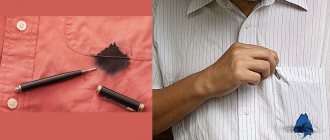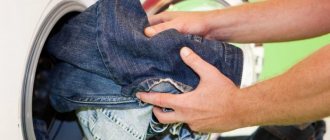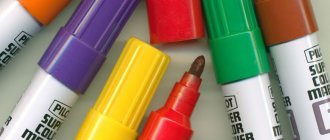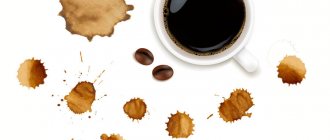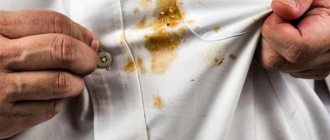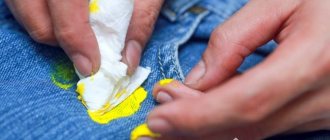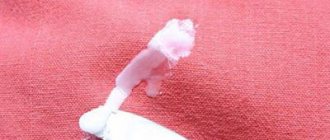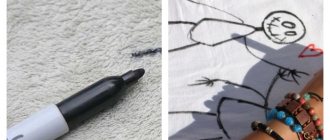Vegetable oil stains on fabric, especially on clothing, are an unpleasant occurrence. First of all, you need to remember that the faster measures are taken, the more reliable the result. There are several reasons for this. Firstly, oil has high fluidity and a drop of the substance on clothing tends to occupy the maximum area. Secondly, the oil tends to be oxidized by atmospheric oxygen and dry out, that is, at this time it goes through the polymerization stage, after which it will be extremely difficult, and sometimes impossible, to achieve complete purification. Dust begins to stick to the oil stain, causing even more contamination. The situation can be alleviated by the fact that sunflower oil is easily dissolved in organic solvents such as gasoline, kerosene, acetone or ethyl alcohol.
Immediate cleaning actions
Let's use what we have, first checking the affected fabric for tolerance to certain cleaning substances. Table salt – sprinkle generously on the stain, gently rub it into the clothes and leave for 5-10 minutes. You can use paper napkins.
Laundry soap works well. To do this you need:
- Pour hot or warm (depending on the composition of the fabric) water into the basin;
- Gently soap the contaminated area;
- Leave to unlock for 2-3 hours;
- Wash in a washing machine.
It will be more difficult if you find yourself visiting, traveling or in a public place. The experience accumulated by more than one generation will help here. Let's try to look at some effective folk methods for removing oil stains.
How to remove old oil stains from clothes
Getting rid of a fresh oil stain on clothes is easier. Even the usual “Antipyatin” will help here. Just lather the “blot” and leave it for an hour, then wash the item as usual. But removing dried oil from clothes is more difficult, but also quite possible, even without washing the item completely. Spot-treat the stain with a mixture of ammonia, cold water and fine table salt (1:1:1). If the contamination persists, try one of the following methods.
- Mustard powder. The product must be mixed with water until creamy. It is recommended to wash the item before cleaning. Then the powder is applied to the dirty area for five minutes, after which the mark is rubbed with laundry soap and washed off.
- Refined gasoline. For example, “Galoshes”. A piece of cloth is generously moistened in the solution and placed under the contaminated area. The stain is wiped from above with a clean material. Then the item should be washed.
- Salt. Half a glass of salt is added to a basin of hot water and the dirty item is placed there. You need to leave it for a couple of hours. Then the product can be washed using powder and stain remover.
When choosing a method for removing oil from clothes, always take into account the type of material, type of oil and the aggressiveness of the products used. You can experiment with thick fabrics: one composition does not work - wash the item and try another. But it’s better to save expensive items made from delicate fabrics and outerwear and have them dry cleaned.
Table salt for purifying sunflower oil
An easily accessible product that no housewife or catering establishment can do without. It is best to use finely ground “Extra” salt. It easily penetrates the pores of soiled clothing, absorbing oily substances.
The effect may be even better if you place a paper napkin or towel on top of the small crystals and iron it. Salt is chemically neutral, so it will not damage your item upon contact.
Baking soda for cleaning sunflower oil
It has a weak alkaline reaction, breaking down and adsorbing sunflower oil. To remove stains, sprinkle the powder onto the surface and rub thoroughly into the fabric with a brush. 20-30 minutes is enough to clean the material.
Natural suede is subjected to this procedure, and bulky pile carpets are washed perfectly. A similar result will be obtained when using tooth powder containing chalk instead of soda.
Removing stains from thick fabrics
How to remove a vegetable oil stain that has got on a dense item? Even for such cases, there are several effective recipes. They are used to remove greasy marks from trouser suits, jackets, and down jackets.
First method
To remove greasy marks, use potatoes. It contains starch, which has the ability to whiten any stain.
Take one vegetable, peel it and grate it on a fine grater. Add some refined gasoline. Stir and then apply to the stain. Leave until completely dry.
Then take a soft brush and remove the remaining composition. To complete the procedure, wash the item in the machine.
Second method
Any of three means will help rid denim clothes of sunflowers - kerosene, tooth powder, gasoline in combination with turpentine.
Experts recommend using tooth powder first. It is odorless and does not harm fabric fibers. It is enough to apply the composition to the dirt, wait 30 minutes, and then wash.
If your white jeans are stained with oil, then kerosene or gasoline are more suitable. Soak a cotton pad in the solution and wipe the stain. Then soak in warm water with bleach for 8-10 hours. To complete the procedure, process the item in the machine.
If oil stains appear on your clothes, don’t worry too much. Any type of dirt can be removed using homemade products.
Before use, perform a reaction test on an inconspicuous area. If the fabric has not deteriorated, then continue the procedure.
Mustard for sunflower oil purification
During the difficult times of the mid-20th century, this substance was widely used to wash clothes. Modern scented cleaning products have replaced natural powders. Although mustard is still used to effectively remove food stains from kitchen towels. It copes well with oil stains.
You need to take water and mustard powder in equal proportions, mix until a thick paste is obtained and apply to a dirty surface. Wait 20-30 minutes, then clean with a soft brush. Wash clothes as usual.
Fighting animal stains
It can be butter or beef fat; no one is safe from the fact that herring oil will not get on your clothes while you are removing the bones. You can get rid of such stains, but the fight should begin immediately:
- Dish gel. It is slightly diluted with water, after which the solution is soaked into the stain.
- White spirit or acetone. You can use nail polish remover. Apply generously to the stain and leave for 20 minutes. Not suitable for synthetics!
- If butter gets on the upholstery of the sofa, you should cover it with a thick layer of baking soda, then wipe it with a rag soaked in stain remover.
Dishwashing detergent
Fairy, AOC, Drop, Sorti - this is an incomplete list of washing shampoos developed by modern chemists to make work easier in the household.
Their main purpose is the breakdown of organic compounds even in cold water. These products are suitable not only for their intended purpose, but also for removing many fatty deposits.
To clean an oil stain you need:
- Apply washing shampoo to the dirty area and rub into the fabric. The measure of acidity - pH - of such preparations is neutral or slightly alkaline, so there will be no harm to clothing. If the material is still delicate, then try first on the wrong side of the seam;
- Pour water into a small container and wash the item;
- Rinse and dry.
Important! Do not use special grease cleaners for ovens and grills. The nature of the action of the drugs is very aggressive and dangerous for the integrity of even the most resistant paints and fabrics.
Removing oil stains with gasoline and solvents
Gasoline is the most aggressive agent, so before using it, you must first try it on an inconspicuous area of clothing. In order to remove a stain with gasoline, soak a cotton pad in it and wipe the stained area, after which the clothes are sent for washing.
Acetone is used in the same way. But it is worth considering that it is capable of dissolving not only fat, but also paint that is used for clothing.
You can also use ethyl alcohol. It is available for purchase at any pharmacy. Unlike acetone, it does not spoil the material, but only dissolves fat.
Gasoline, benzene, turpentine
To use these solvents, you first need to make a test on the lining or back of the garment. Cotton, linen items or those containing a small percentage of synthetics must be cleaned. The most effective work will be done when potato starch is added to the solvents.
Important! Do not use motor gasoline to remove contaminants. Numerous toxic additives make the fuel itself difficult to remove from any fabric.
For this purpose, you should purchase well-refined gasoline, kerosene or turpentine at hardware stores. Cleaning algorithm:
place a piece of cotton textile or paper towel under the stain;
- Moisten a clean cloth with solvent;
- Wipe the dirty area with a damp cloth from the edges to the center;
- Treat the rim that has formed as it dries with a swab dipped in gasoline.
The main thing is speed!
The main rule to follow when you get oil on your clothes is to act as quickly as possible. The fact is that oil has high fluidity, and even a small drop falling on the fabric quickly spreads and turns into a stain of quite impressive size. In addition, the oil oxidizes and dries out quite quickly during the polymerization stage. A dried oil stain will be quite difficult to wash off, in some cases even impossible. Also, the oil stain will begin to attract particles of dust and dirt, which will make removing the stain even more difficult.
In order to quickly get rid of oil that gets on your clothes at home, you can use one of the following remedies:
- Salt;
- Dish detergent;
- Mustard powder;
- Soda,
- Solvents or gasoline (for particularly difficult stains);
- Stain remover;
- Soap or washing powder.
The use of each of their means has its own characteristics and methods. Therefore, it is worth familiarizing yourself with each of them in more detail.
Stain removers
When using products specially designed for cleaning clothes and household items, you should strictly follow the instructions to avoid damage.
A variety of household gels, powders, and rollers contain fat breakers, active oxygen, surfactants, flavors and other additives.
An excellent grease remover can be prepared at home.
- To do this, you need to take equal parts of purified gasoline, ammonia and ethyl alcohol or vodka.
- Apply the resulting solution to the oil stain and wait 15-30 minutes.
- If the contamination is old, the time increases to one and a half hours.
- Then you should rinse the item in cold water.
Effective ways
There are many ways to remove sunflower oil stains, and the choice among them is determined by the type of fabric, capabilities and availability of the necessary products.
What can you do first?
A foolproof way to remove oil stains from pants, T-shirts, or other clothing.
- Sprinkle the stain with salt and rub a little, leaving it for about 10 minutes; laundry soap will also work.
- After that, the item needs to be washed with vegetable oil in the washing machine. Washing items will completely remove dirt from any clothing.
- It’s even better to entrust stain removal to a specialized dry cleaner.
Unfortunately, washing is not always the solution. A simple example - you are visiting. Other methods are needed here. Proven folk methods come to the rescue that will help you quickly remove all kinds of greasy stains from any thing, be it a jacket or pants, a towel or a tablecloth.
Salt
A time-tested way to reduce contamination is to immediately sprinkle the problem area with fine table salt. Table salt absorbs oil perfectly and in some cases the stain can practically disappear. The finer the grind, the better the effect. If possible, place a paper napkin on top of the salt and iron with a hot iron.
Dish detergent
You can quickly remove a greasy stain from any fabric by manually washing the stained area in water to which ordinary dishwashing detergent has been added. Most of these drugs are designed to break down any fats at normal temperatures. A few minutes of washing will help return things to their original appearance. Just do not use all kinds of cleaners for ovens, stoves, grills and the like, which contain aggressive chemical additives that are guaranteed to ruin your clothes. Colored fabrics, including jeans, can be especially affected. The method can be considered optimal when cleaning things that are used in the kitchen. This is how an apron or towel often becomes a victim of oil and the easiest way is to solve the problem right on the spot without wasting time.
Mustard powder
Mustard works well on stains. Mix a small amount of powder with water to form a thick paste and apply to the contaminated area. After drying, the mustard is cleaned with a soft brush. The clothes are then washed as usual.
Baking soda
Baking soda acts on greasy stains in two ways - it absorbs excess oil and by breaking down fat, since it is an alkali. To remove stains, thoroughly rub soda into the surface with a brush, and after 15-30 minutes I remove it. This method cleans suede well. It also washes carpets with pile that cannot be thrown into the washing machine. Instead of soda, you can use tooth powder, which also contains chalk, which absorbs various substances well.
Gasoline and solvents
You can clean cotton fabric using solvents, gasoline or kerosene. The effect is achieved when gasoline is mixed with potato starch and the mixture is applied to a stain on the fabric. It is important to know that it is not recommended to use motor gasoline.
- Firstly, it contains toxic additives; Secondly, it itself leaves stains that are difficult to remove;
- Thirdly, its smell is difficult to remove.
You should only use refined gasoline or kerosene, which are sold in hardware stores, and the best option is lighter fuel.
Cleaning with flammable liquids is as follows. Place a piece of clean cloth under the area of clothing to be cleaned, generously moisten the stain with gasoline or acetone and iron the top with an iron through a paper napkin. Be careful! Gasoline, and especially acetone, are highly flammable liquids. In addition, acetone is very volatile and simply rubbing the stain will not work, since it will evaporate quickly.
This technique is used only on light cotton fabrics, but it will help remove even old greasy stains that cannot be washed with regular washing. Contact of gasoline or acetone with paints or synthetics can lead to irreparable consequences. Raincoat fabric will easily fall apart under the influence of a solvent, especially if the material is not of high quality.
A gentle solvent is ethyl alcohol. Of course, it works somewhat worse than gasoline, but it has an undeniable advantage - after drying it has absolutely no odor. If it is not available, use vodka, but not tinctures, which contain a lot of other things besides alcohol.
Stain removers
The use of all kinds of stain removers also occurs when cleaning things. The main thing is to comply with the manufacturers’ requirements for fabrics and follow the instructions. All cleaning products contain surfactants, fat breakers and other additives that cope with most known contaminants.
At home, you can prepare a simple stain remover that can remove even old oil stains. Mix pure gasoline, ethyl alcohol and ammonia in equal proportions. The resulting mixture is applied to the stain for a period of 15 minutes to an hour and a half, depending on the degree of contamination. After exposure, the clothes are rinsed in cold water. If the result is unsatisfactory, repeat the procedure or try to clean things in a different way.
Soap and washing powder
Using laundry soap or washing powder, you can wash away stains caused by spilled oil on the carpet. It is difficult to remove fat from dense and fleecy items because they are capable of absorbing a significant amount of liquid.
First, moisten the area around the stain with water to prevent it from spreading further. Now you need to carefully blot the center of the stain with a clean napkin until no greasy dirt remains on it, after which water is applied to the stain itself. To remove grease, soak a stiff clothes brush in warm water, rub a bar of soap with it, or lightly sprinkle the carpet with laundry detergent and vigorously rub the pile with a brush until a thick foam forms. Rinse off the detergent with water to ensure that the grease is gone.
In order not to spoil the floor covering, which is afraid of water getting in, place a layer of oilcloth under the carpet, and then a piece of clean cloth.
Carpet cleaning
What to do if insidious oil spills on your favorite piece of furniture? First, blot the excess product dry with paper towels.
Next, laundry soap and washing powder will be used:
- Place a piece of polyethylene under the carpet, and then any clean cloth to avoid damage to the floor covering;
- Moisten the surface of the dirty layer and a little around it with water so that the stain does not increase;
- Take a stiff brush, soap it or add a little powder;
- Rub the detergent into the pile;
- Rinse and blot the clean item with a dry cloth.
Fighting vegetable oil stains
Most often, minor troubles happen when you are cooking in the kitchen, frying, or just eating a salad. Popular masks with coconut oil also sometimes pose a difficult task for housewives.
How to remove a stain from sunflower, corn or coconut oil:
- Remove excess oil with a paper towel. Use plain white, otherwise you risk transferring the dye to your clothes.
- Cover the stain with baking soda. You can use cornstarch.
- Leave for 30-60 minutes, then scrub the stain with an old toothbrush.
- Pour some liquid soap and lather it.
- Machine wash following label instructions. Hot water helps dissolve fat, but not all products can withstand high temperatures.
- Add 200ml white vinegar to the drum. This will make washing more efficient.
- Make sure the result is achieved before drying and ironing the item.
Some Caveats
It is much easier to remove fresh dirt from the surface than dried and crusted dirt.
When working with any fabric, do a test test on the wrong side of the seam or hem of the fabric. Be careful with delicate material.
Do not use plumbing cleaners. They are too aggressive.
When using stain removers, carefully read the instructions - the chlorine they contain will permanently ruin any item.
When working with solvents - gasoline, turpentine, ammonia, use hand protection and do not forget to open the windows.
Features of cleaning different fabrics
Any grease remover should be selected depending on the structure of the fabric from which the clothing is made.
We recommend:
How to remove rust from clothes
Important! Aggressive cleaning agents (gasoline, acetone and others) are not suitable for wool, silk and some types of synthetics. Using them to clean delicate fabrics can discolor the product and distort the fibers. These substances are used only for durable fabrics with a dense structure. It is recommended to treat stains on such clothes on both sides at once.
Denim pants and a jacket, which quickly absorb any oil, can be peeled with raw potatoes.
A solution of salt and alcohol (1:3) is also used. After rubbing the mixture into the stain, wait 10-15 minutes until it is completely absorbed and rinse the item with cool water.
Fat is removed from delicate fabrics using salt, chalk, starch and other available means. Ammonia in combination with warm water also helps (1 teaspoon of alcohol is diluted in 250 ml of water). A cotton swab is moistened in this solution and the stain is wiped, after which a cotton cloth is placed on it and smoothed.
